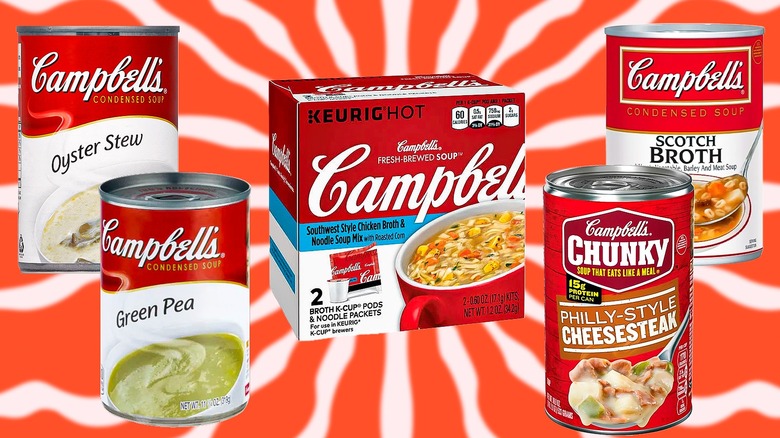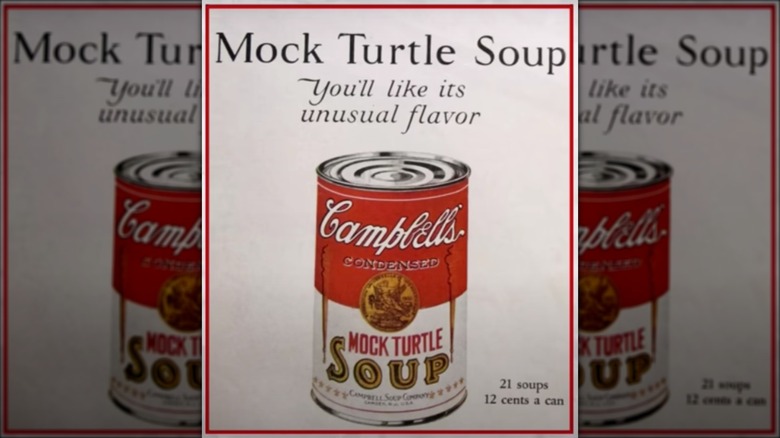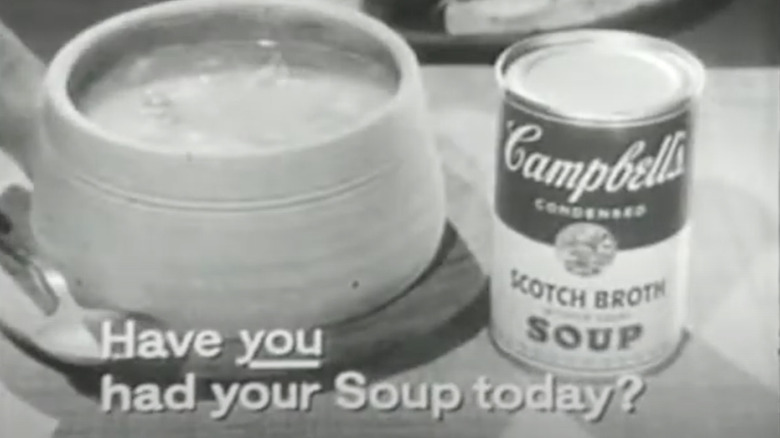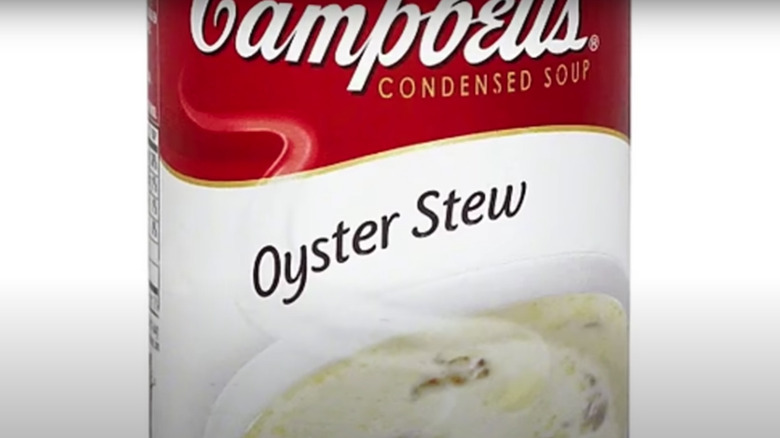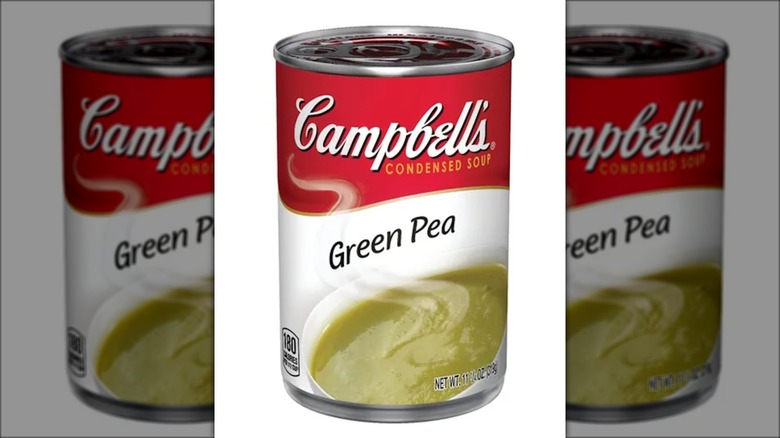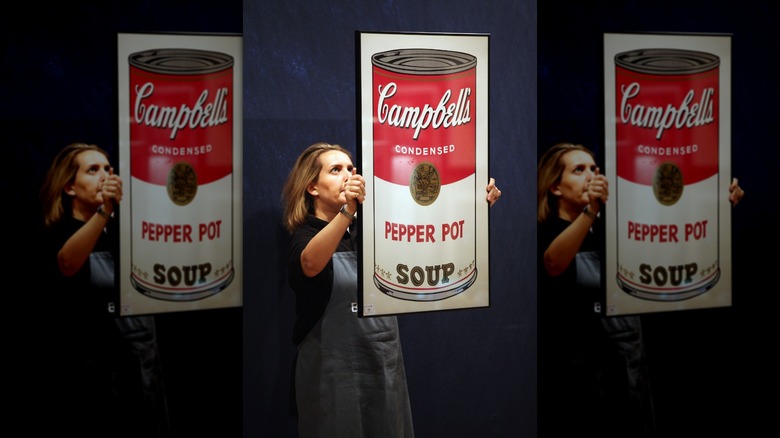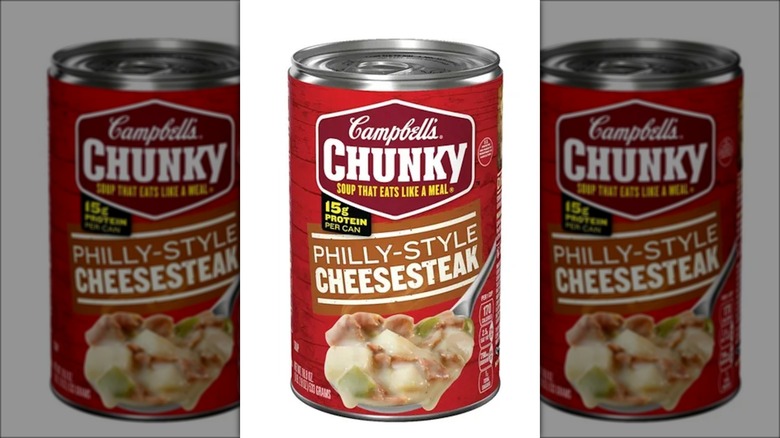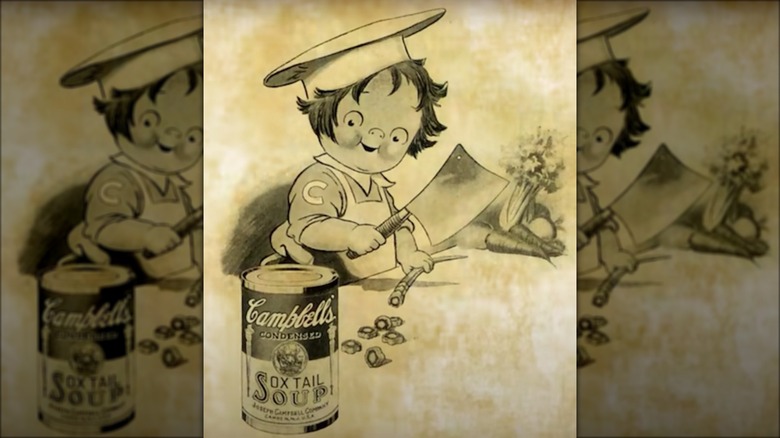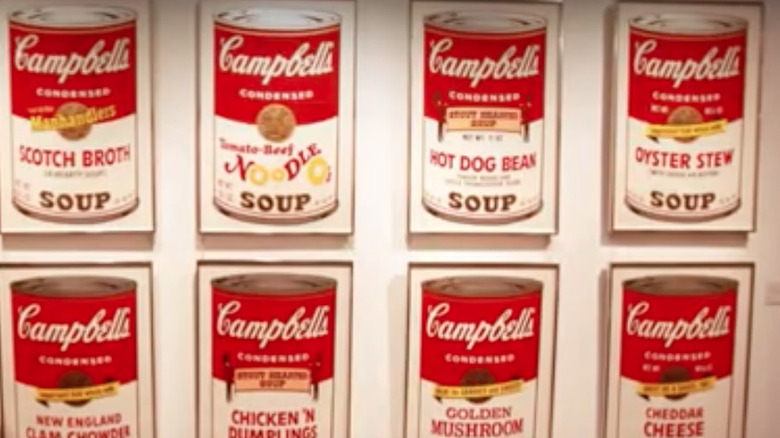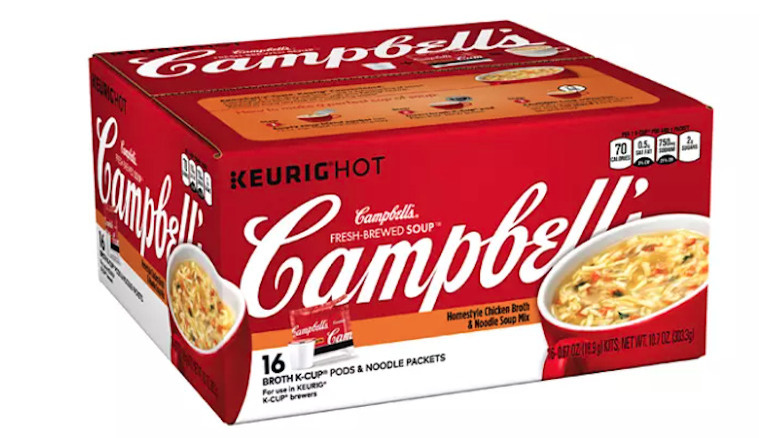Discontinued Canned Campbell's Soup We Wish Would Make A Comeback
Since its founding in 1869, the Campbell's Soup Company has launched many notable or quirky (though usually delicious) soup flavors, like Mock Turtle and Ox Tail. It has also pulled those and other soups off the shelves, never to be seen again. And if recent company news offers any clues about the direction that some of the company's soups will take in the future, the practice of tossing soup flavors into the proverbial trash kettle won't go away anytime soon.
On September 10th of this year, the soup giant announcement of its decision to remove "soup" from its iconic name, making it just the Campbell's Company now. It also revealed that it would give other foods, like snacks, a more pronounced place in the company's portfolio. To give you some context, while consumers' desire for the company's snack fare, like Goldfish, rose by 13% last year, their demands for Campbell's soups only inched up by 3%, per USA Today.
Given the role that some of these soups have played in people's lives over the years, this shake-up may make soup fans even more nostalgic for their old favorites. No one can predict what other Campbell's brand soups might disappear from shelves, to be forgotten forever. However, there are at least nine discontinued Campbell's soup flavors that soup lovers haven't forgotten and would still love to see back on the shelves once again.
Mock Turtle
Despite being inspired by a once-luxury food, Campbell's Mock Turtle soup eventually passed into extinction — an irony considering that actual turtles nearly went extinct due to being a staple ingredient in turtle soup. From the mid-19th and early-20th centuries, society's upper crust had developed such a taste for turtle soup that diamondback terrapins became endangered.
It was only Prohibition — yes, that Prohibition — and the invention of mock turtle soup that pulled terrapins back from the brink. This had less to do with saving turtles and more to do with preventing people from pouring sherry into their turtle soup, but nonetheless, it worked.
Mock turtle soup isn't actually made from turtle at all, but rather cow's head, feet, and other pieces of meat and offal. Apparently, the texture and consistency of these ingredients mimic turtle meat, and by the early part of the 20th century, Campbell's threw its can into the ring in order to lap up some of the sales it would surely get from offering such a chi chi item.
The soup giant made its mock turtle soup from cow's head, herbs, and a tomato base, and shipped those delicacies to around the world. The cost was extreme, apparently. Only those who were well-monied could afford it, despite it basically being just canned beef and tomato soup. By 1960, the soup lost its luxury status and the soup company stopped selling it.
Scotch Broth
Scotch broth soup – aka Scotch barley soup – has satisfied hungry bellies since at least the mid-1700s. Typically made from mutton or lamb as well as a plethora of vegetables like celery, carrots, onions, turnips, and even raisins in some of the oldest iterations of the soup, Scotch Broth soup was a favorite among Campbell's soup eaters. One of the soup's most ardent fans claimed that they ate it for more than 40 years, per The Sun. That's the kind of staying power the soup had.
Despite this, Campbell's discontinued the soup in 2023, causing quite a stir among the soup's most faithful fans. Scotch broth soup eaters begged Campbell's to at least post a recipe for the soup on its website. Its Canadian iteration answered fans' pleas and now hosts a recipe for the soup on a specialty site dedicated to recipes made from Campbell's products. (That version of the soup calls for Campbell's beef broth, for the record.)
As for why the soup giant decided to take Scotch broth soup off the shelves, the company said in an X, formerly Twitter post, "We sometimes discontinue certain items so we can focus our efforts on upcoming offerings."
Oyster Stew
Discontinued in September 2012, Campbell's Oyster Stew was a creamy soup similar to mushroom soup, except with oysters. Possibly due to the myth that oysters cure hangovers, the creamy soup, plus a little lemon juice, became the remedy of choice for some who had over-imbibed.
In June of 2012, just months before Campbell's pulled oyster stew off the shelves, it had voluntarily recalled its 10.5-ounce cans of the soup due to worries about the concoction being made with Korean oysters. There were concerns over the pollution levels the oysters were subjected to. When Campbell's announced via its X account that it had decided to pull the stew from the shelves, it gave no reason why, so it's unclear as to whether the soup's discontinuation came as a result of declining sales, health concerns, or something else.
The only traces of the soup that remain now are the broken links to online food sites, like Walmart, and a 1969 poster by Andy Warhol. Despite the challenges that Campbell's Oyster Stew faced, there might be a reason to bring the soup back, at least temporarily, each year: Lent, that season when fish replaces all other meat products. This assumes, of course, that there is a safe supply of oysters from which Campbell's can draw from.
Green Pea
Lovers of Campbell's Split Pea With Ham and Bacon Soup might think that the soup offers a good substitute for the brand's discontinued Green Pea soup. However, ham — the ingredient that likely makes split pea soup fans love it — is probably also the reason why its detractors long for Campbell's Green Pea soup to return. With ingredients like split peas, water, salt, flour, and sugar, plus a bit of onion and celery extract and butter, it lacked meat, making it a great soup for the vegetarian soup fan.
In response to a 2019 customer inquiry on X, Campbell's announced that it would no longer carry its Green Pea flavor. In its place, the soup giant recommended Habitant French Canadian Pea Soup, a product made with yellow peas and lard instead of green peas and butter. While the taste might be similar enough to satisfy green pea soup fans, the lard content takes it off the table as an option for vegetarians.
Pepper Pot
If soups were capable of being sad at being discontinued, at least Campbell's Pepper Pot soup could take consolation in the fact that it had a good run before its demise. After being a fan favorite for at least 100 years, Campbell's pulled the soup from the shelves rather suddenly in 2010. With ingredients like hearty potatoes and carrots, aromatic onions, as well as red pepper flakes and jalapeño peppers, it was a soup that had enough bulk to fill the grumbliest of tummies. And with healthy helpings of tripe as its main meat offering, the recipe offered a glimpse into the bygone era from whence it originated.
Campbell's first rolled out the soup in 1899 after pepper pot soup became popular — first in Philadelphia and later throughout the country. The recipe was Caribbean in origin and in all likelihood arose from kitchens of enslaved people. It was a mixture of African, European, and Native American cuisines, a kind of dish that one would cook when there were leftovers that needed to be used up. No recipe necessary, though perhaps as a courtesy to fans, Campbell's apparently did post the ingredients on its website for fans to use if they wanted to make their own version of the soup.
The rationale behind the soup company's decision to put the kibosh on the recipe had to do with its declining popularity and the fact that the original recipe didn't fit modern sensibilities. This isn't much consolation to die-hard fans who claimed to have even made treks to Canada to get the soup while it was still available.
Chunky Philly-Style Cheesesteak
It's no secret that people stocked up on canned non-perishables, like Campbell's soup, during the COVID-19 pandemic, but what they did not stockpile was specific soups like Chunky Philly-Style Cheesesteak soup. And why? Because the soup company discontinued the flavor during the pandemic in order to make room for other — apparently more popular — soups to sit on store shelves.
Containing all the ingredients of a Philly cheesesteak sandwich plus chunks of potatoes, this soup was like a meaty, cheesy sandwich and French fries in a cup. It was also a specialty soup that Campbell's released in under its Chunky brand in 2014 to celebrate Super Bowl XLVIII. The soup giant, an official sponsor of the big game that year, released Philly-Style Cheesesteak soup, along with Spicy Chicken Quesadilla and Hearty Cheeseburger, as a part of its game-day celebration activities. It was even a featured soup in a food truck that sat onsite at the MetLife Stadium to help warm up tailgaters while they waited for kickoff. Who could have guessed that this hearty Super Bowl soup would be taken from the shelves just six years later?
Ox Tail
A 1922 ad for Campbell's Ox Tail Soup extolled the ingredients of the soup. It consisted of a tasty broth, carrots, potatoes, barley, tomatoes, and ox tails, the "very tenderest and finest the market affords," as sales page for a vintage soup ad for sale on eBay revealed. The old-time ad hints at what oxtail soup used to be – an inexpensive way to use up every last piece of the animal, and given it was only 12 cents a can back then, it probably was economical, indeed.
Despite being made of what can only be kindly called throwaway parts, the soup was likely really tasty. Ox tail is the kind of meat that needs to cook for hours to make it tender enough to eat, but it's flavorful fatty content makes the result worth the wait. Some version of the recipe has been made for hundreds of years, going back to the 1700s. It started with Flemish and French immigrants in London before becoming a popular and cheap meal option for ox tail soup fans from Russia to South America.
Nowadays, because ox tail, ironically, holds delicacy status due to the popularity of the farm-to-table movement, it's likely that this former Campbell's soup would be popular if you could find it on store shelves. But alas, that isn't the case. Since at least 2011, people have been searching high and low for the soup in their local stores, according to various Internet forums.
Hot Dog Bean
Apparently, art fans love Campbell's Hot Dog Bean soup more than the soup company did. In 2013, a collector of Andy Warhol's work bought 35-inch X 23-inch silk screen print featuring the franks-n-beans soup, per Altan Insights. Warhol created the original in 1969, and from his print, soup lovers know that it was a "stout hearted soup" made from "tender beans and little frankfurter slices," according to a poster on Revolver Warhol Gallery. Given that this is all that's left of the soup theses days, soup fans will just have to imagine how the soup tasted when it was still on the market.
For being such a famous soup, thanks in no small part to Warhol's work, Hot Dog Bean soup left the market with relatively little fanfare. It's unclear when the soup company pulled the soup from its line-up. A quick perusal of the company's site nets all kinds of beanie concoctions, except that one. It just disappeared. Were it not for Warhol's work, the soup probably would have slid into oblivion with nary a word otherwise. Due to the nostalgia factor alone, it'd be a soup that'd be fun to have back on the shelves, even for a short run.
Campbell's K-Cup Soups
Convenience coffee and soup fans probably got their hopes jacked up, unnecessarily it turns out, when Campbell's partnered with Keurig to create essentially a cup of soup that you could make in your coffeemaker. However, it didn't take long for the concept (and the subsequent soup offerings) to go by the wayside. The soup company announced the partnership and the release of the mini soups in 2014. By 2016, the K-cup soups got taken off the shelves due to unappetizing sales numbers.
Despite being a clever concept, the fun-sized soups gave users reasons to pause. For one thing, consumers thought the mini cups created a great deal of waste. And for another, the miniature soups didn't provide enough sustenance to carry people through the day. True enough, they were only meant to be snack-sized, but soup fans tried eating them for lunch, anyway.
Still, they might have enjoyed more popularity if the soup and coffee companies had taken aim at niche markets. These mini cups of soups could represent a near-genius solution to cooking space constraints faced by those who live in dorm rooms or in a camp trailer, given how few items the set-up required — just the K-cuppa soup, your Keurig coffee machine, and a spoon.
